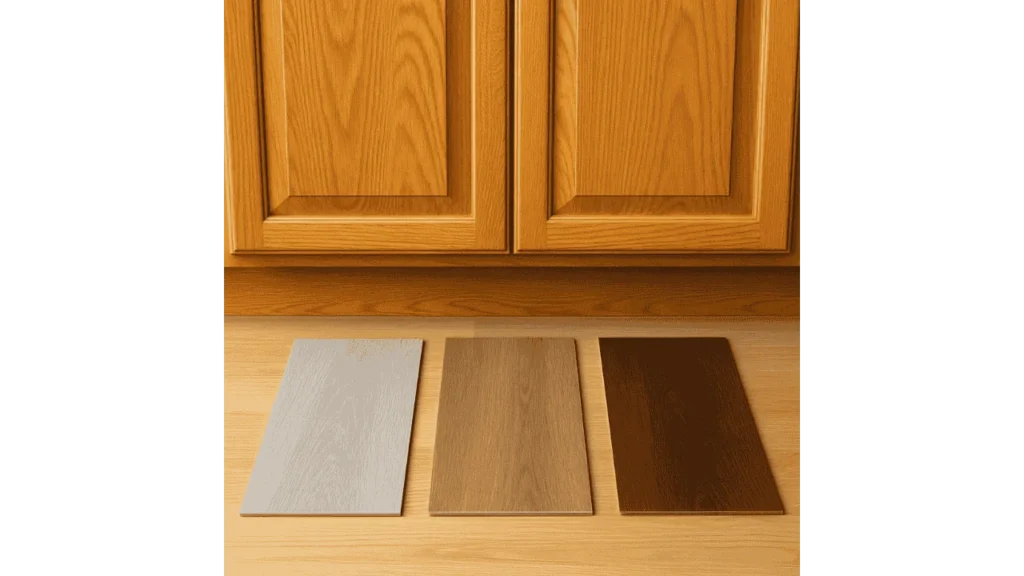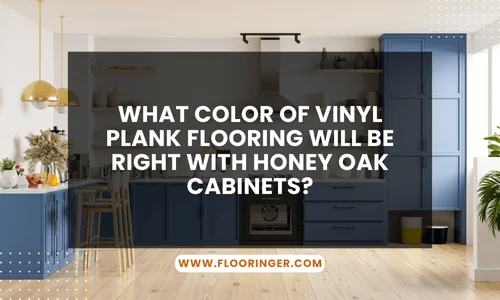Honey oak cabinets have a warm, golden glow that can make a room feel instantly welcoming, yet matching flooring to those distinctive tones takes more thought than simply picking a “wood‑look” plank. Vinyl plank flooring comes in hundreds of shades, and the choice you make will either amplify the oak’s cozy appeal or clash with it. Before defaulting to the first sample that looks “close enough,” let’s unpack how color temperature, room lighting, and overall décor style affect the final look, and why nailing the right hue can elevate the entire space.

Understanding the Tone of Honey Oak Cabinets
Honey oak is prized for its golden undertones and pronounced grain, making every cupboard door feel handcrafted. The wow factor is warmth, but too much yellow or orange in surrounding surfaces can tip the room from inviting to overwhelming. Designing around honey oak, therefore, comes down to balancing warmth rather than competing with it. Interior stylist Rachel Li explains,
“Think of honey oak as the room’s built‑in accent color. Your flooring should either ground that warmth with neutral stability or provide subtle contrast, not fight it.”
Complementary vs. Contrasting Colors: Which Strategy Works?
Choosing a complementary color means selecting a plank in the same family, a light beige, soft caramel, or gentle medium brown. These hues echo the oak’s warmth, allowing cabinets and flooring to blend seamlessly. The room feels cohesive, almost tone‑on‑tone, which works beautifully in traditional or farmhouse kitchens.
A contrasting approach relies on cooler undertones, soft gray, greige, or even a rich espresso to create visual tension. Cool flooring tempers the oak’s golden cast, lending a modern vibe. Designer Marcus Grant notes,
“A cool gray plank next to honey oak is like adding stainless hardware: it updates without erasing the wood’s character.”
Both approaches succeed when executed thoughtfully; the wrong execution, however, can make cabinets feel brassy or floorboards look ashy.
Read More: How to Install Stainmaster Vinyl Plank Flooring?
Light and Neutral Tones: Why They Often Win
Because honey oak already supplies warmth, light neutral planks keep things airy. Think creamy beige with faint driftwood streaks or a pale white‑oak look washed with subtle taupe. These hues bounce natural light, expand visual square footage, and allow decorative accents, backsplash tiles, countertop stone, or a painted island to take center stage. The key is subtle variation in the plank so the floor feels layered, not flat.
Cool Gray Tones: A Contemporary Counterbalance
Gray vinyl plank, once trendy, now reads as a staple of modern palettes. When paired with honey oak, choose a medium‑light gray with a hint of brown (often labeled “greige”). Too blue a gray competes with the oak’s yellow, but greige threads the needle, delivering gentle contrast without harshness. The result is a kitchen that feels current, with the oak grain now the star rather than the sole color story.
Medium Brown Shades: Cohesion Without Monotony
If your cabinets lean amber but your floor lands in the medium‑brown zone, walnut or chestnut hues, you achieve depth without monochrome overload. The grain differences stand out, giving the room dimension. Aim for a plank that is slightly darker than the cabinets so the base cabinets don’t visually disappear; that subtle value shift delineates surfaces and provides classic harmony.
Dark Flooring Options: Sophistication for Larger Spaces
For expansive kitchens or open‑concept homes, espresso or rich walnut vinyl plank injects drama. Dark floors set off lighter oak cabinetry, grounding the room and emphasizing vertical lines. In smaller kitchens, though, the same dark plank might shrink the footprint. Good lighting, both natural and under‑cabinet, offsets that risk and makes the contrast feel luxurious rather than cave‑like.
Factors Beyond Color: What Else Matters?
Room size and lighting dictate whether a hue enlivens or overwhelms. A tiny galley lined with oak benefits from airy tones; a sunlit, vaulted kitchen can handle bolder contrast. Overall design style matters too: rustic spaces invite warm neutrals, while sleek, modern designs thrive on cool or dark planks.
Maintenance cannot be ignored. Light planks highlight spills; dark planks reveal dust. A mid‑tone greige often hides both. Vinyl plank’s durable wear layer helps, but lifestyle, pets, kids, and culinary enthusiasm should guide your final shade.
Final Takeaways
The “right” vinyl plank color for honey oak cabinets is less about a single perfect shade and more about finding equilibrium. Complementary light neutrals keep things open and cohesive, while contrasting grays or deep browns lend modern flair or sophisticated drama. Measure your room’s light, weigh your design goals, and lean on samples; view them against the cabinetry at different times of day. With thoughtful selection, the floor will anchor your kitchen, letting that timeless honey oak glow rather than overpower.
